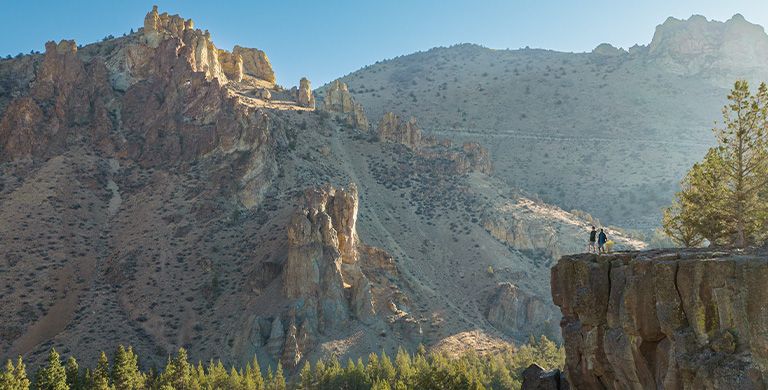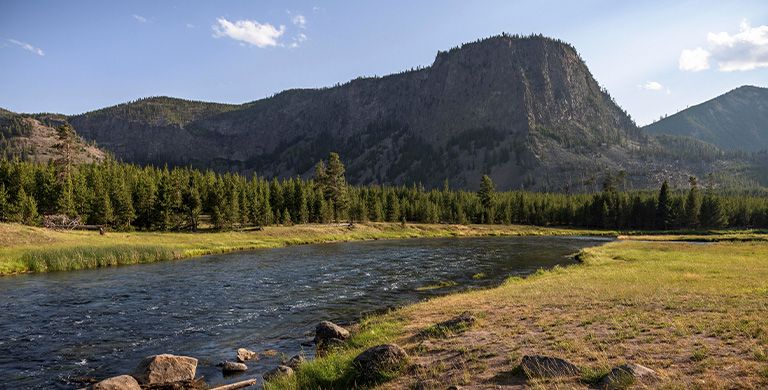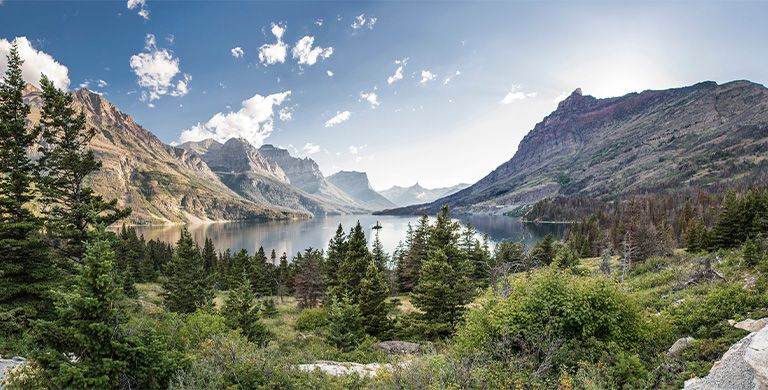EXPLORATION
Columbia Sportwear’s Guide for Outdoor Accessibility
The outdoors is for everyone. Learn more about a range of accessible outdoor activities.
BY NANCY BOUCHARD
There’s something magical about spending time outdoors. Breathtaking scenery has long inspired some of the world’s most iconic works of art, poetry, and literature. But beyond that, there’s the profound experience of connecting with nature — whether you are sitting, walking, or otherwise exploring. Engaging in outdoor activities like fishing, walking, skiing, birding, kayaking, golfing, or simply driving along backcountry roads offers something invaluable, with benefits that are both physical and mental.
Getting outside isn’t just about exercise, making friends, or unwinding; it’s also about accessibility. For individuals with limited mobility or fitness, just the idea of outdoor recreation can present additional challenges. Accessibility can mean different things to different people, from parents with young children, to age-related constraints, to non-traditional outdoor enthusiasts, to individuals working with mental or physical challenges and disabilities.
Kareemah Batts, program director at the Appalachian Mountain Club (AMC) and founder of The Adaptive Climbing Group, as well as a former para-climbing competitor, emphasizes that taking the first step into an activity is often the most challenging. "The initial hurdle to accessibility for many outdoor pursuits is fear," she explains. "What people see in movies and videos isn't always an accurate portrayal and can be overwhelming."
Batts suggests starting with a "gateway" introduction by joining a club, organization, or experienced group. Joe Jackson, Oregon Adaptive Sports program director for Mt. Ashland, shares a similar perspective: "Outdoor opportunities aren't necessarily about extreme feats like cliff drops or ultra runs," he notes. "There are numerous other activities with lower barriers to entry that are as simple as walking or biking along a paved path."
The solution is to find ways to get outdoors and start new sports. Overcoming barriers to outdoor activities is crucial, and here are some tips to help everyone enjoy the outdoors more.
Getting outside isn’t just about exercise, making friends, or unwinding; it’s also about accessibility. For individuals with limited mobility or fitness, just the idea of outdoor recreation can present additional challenges. Accessibility can mean different things to different people, from parents with young children, to age-related constraints, to non-traditional outdoor enthusiasts, to individuals working with mental or physical challenges and disabilities.
Kareemah Batts, program director at the Appalachian Mountain Club (AMC) and founder of The Adaptive Climbing Group, as well as a former para-climbing competitor, emphasizes that taking the first step into an activity is often the most challenging. "The initial hurdle to accessibility for many outdoor pursuits is fear," she explains. "What people see in movies and videos isn't always an accurate portrayal and can be overwhelming."
Batts suggests starting with a "gateway" introduction by joining a club, organization, or experienced group. Joe Jackson, Oregon Adaptive Sports program director for Mt. Ashland, shares a similar perspective: "Outdoor opportunities aren't necessarily about extreme feats like cliff drops or ultra runs," he notes. "There are numerous other activities with lower barriers to entry that are as simple as walking or biking along a paved path."
The solution is to find ways to get outdoors and start new sports. Overcoming barriers to outdoor activities is crucial, and here are some tips to help everyone enjoy the outdoors more.

Don’t measure yourself against anyone else
Avoid comparing yourself to others, especially those portrayed on social media feeds of sponsored athletes and influencers. It might seem like everyone is thru hiking the Appalachian Trail, soloing Yosemite’s El Capitan, or swimming with sharks, but that's far from the reality. Even those who achieve these feats started small, with activities like short day-hikes, indoor climbing, or swimming lessons. Everyone begins somewhere, and the journey to outdoor adventures starts with taking those initial steps, no matter how modest they may seem.
Do Some Research
Everyone defines a viable outdoor adventure differently. "If you have restricted mobility or other medical issues, adjusting your activity to match your physical and mental comfort level is crucial," notes Batts. "What is accessible varies greatly among individuals," she adds. "The possibilities depend on life experience, fitness, and mobility.” Conduct thorough research before embarking on any outdoor activity. "A two-mile hike can feel much longer if it involves significant elevation gain," she explains. Look for an outdoor club that focuses on an activity that you are interested in trying.
Explore Local Paved Paths and Trails
Public parks offer trails that are ideal for beginners or those who prefer not to venture into rugged backcountry terrain. Fitness can start with walking; begin with ten or fifteen minutes and gradually increase your time and distance. If you're interested, progress to dirt trails. Seek out "all person" trails that are accessible to everyone. Batts highlights the Appalachian Mountain Club's (AMC) All Person’s Trail in New Hampshire. This one-mile loop on Cardigan Mountain is designed for accessibility, accommodating wheelchairs, walkers, strollers, and other adaptive devices.
Jackson emphasizes that there are numerous ways to enjoy the outdoors without extreme activities. "Access to outdoor experiences doesn’t have to involve ski slopes, mountain bike trails, or Class IV whitewater," he explains. "For instance, Ashland, Oregon offers the Bear Creek Greenway, a scenic bikeway alongside a creek. There are plenty of opportunities for everyone to begin exploring the outdoors."
Jackson emphasizes that there are numerous ways to enjoy the outdoors without extreme activities. "Access to outdoor experiences doesn’t have to involve ski slopes, mountain bike trails, or Class IV whitewater," he explains. "For instance, Ashland, Oregon offers the Bear Creek Greenway, a scenic bikeway alongside a creek. There are plenty of opportunities for everyone to begin exploring the outdoors."

Take Swimming Lessons
Swimming is excellent exercise. The stronger the swimmer you are, the safer you’ll be and the more fun you’ll have. Many public swimming pools now require a swimming test for access to deeper water. The American Red Cross provides swimming lessons for all ages. Take a refresher lesson, or two, to make sure you are water safe. Then consider a visit to a local swimming hole. Renting a SUP (stand-up paddleboard) or kayak at a nearby river or lake is also a great way to explore; always wear a lifejacket on any watercraft, regardless of your swimming ability.
Take advantage of scenic drives and backroads
The US and Canada offer abundant opportunities for backcountry exploration, catering to both human-powered travel and various types of vehicles. Many of our public lands allow, and even encourage motorized and electric vehicles.
Across the states, there are over 150 million acres of public land, much of which is accessible for off-roading enthusiasts. In the US, approximately one-eighth of the land is managed by the Bureau of Land Management (BLM), which includes over 45,000 miles of paved roads and more than 400,000 miles of dirt roads and trails open to vehicles.
You can choose to drive independently, join a guided tour, or rent vehicles such as 4x4s, side-by-sides (SXSs), ATVs, or dirt bikes to explore these vast landscapes.
Across the states, there are over 150 million acres of public land, much of which is accessible for off-roading enthusiasts. In the US, approximately one-eighth of the land is managed by the Bureau of Land Management (BLM), which includes over 45,000 miles of paved roads and more than 400,000 miles of dirt roads and trails open to vehicles.
You can choose to drive independently, join a guided tour, or rent vehicles such as 4x4s, side-by-sides (SXSs), ATVs, or dirt bikes to explore these vast landscapes.
Pay attention to elevation
It's widely acknowledged that engaging in outdoor exercise at sea level is generally easier than at higher altitudes. If you're new to outdoor sports and contemplating activities like boating, hiking, swimming, or fishing—anything that involves aerobic exertion—starting at a lower-elevation destination is advisable.

Don’t forget birdwatching, painting, and simply enjoying the view
There are numerous outdoor activities that allow you to experience nature at your own pace. Sometimes, the question becomes "what can I do outdoors?" Activities such as birdwatching, painting or sketching, and simply relaxing in a beach chair are excellent ways to enjoy fresh air and immerse yourself in the outdoor world.
Adaptive Sports
Don’t let your disability hold you back. "Living in an area with an adaptive sports program can provide incredible opportunities to explore a variety of outdoor sports," says Jackson. "For instance, Oregon Adaptive Sports (OAS) works diligently to remove barriers to outdoor activities for individuals with disabilities." OAS offers experiences in golfing, biking, skiing, snowboarding, and snowshoeing.
To discover similar opportunities in other states, connect with one of over 240 community-based adaptive sports groups across 45 states that are part of Move United’s member network. These organizations not only offer adaptive outdoor sports and recreation opportunities but also provide guidance on accessing the outdoors based on individual accessibility needs.
To discover similar opportunities in other states, connect with one of over 240 community-based adaptive sports groups across 45 states that are part of Move United’s member network. These organizations not only offer adaptive outdoor sports and recreation opportunities but also provide guidance on accessing the outdoors based on individual accessibility needs.
Adaptive equipment
There is a wide range of adaptive equipment designed to enhance outdoor enjoyment for individuals with limited mobility. Many paved trails are accessible for users of wheelchairs, walkers, hiking poles, and other adaptive aids. Additionally, specialized motorized wheelchairs are available for navigating trails and beaches. Oregon-based David’s Chair provides motorized track and para golf chairs at various recreation sites across Oregon, Washington, and Nevada. These innovations significantly broaden accessibility, enabling individuals to access and explore natural environments more easily.

Boating and fishing
Boating is a fantastic way to enjoy the outdoors. For those with limited mobility, there are numerous guided excursions available, ranging from kayaks and rafts to motorized boats. Fishing also provides an excellent opportunity to connect with nature, offering a wide range of options suitable for beginners. Adaptive equipment such as fishing poles and assistive devices are available to enhance the experience for individuals with limited mobility. Guided rafting trips further provide an immersive way to experience and appreciate the natural world.
National Parks
National parks prioritize accessibility for all visitors. When planning a visit, you can review the accommodations offered at each specific park. If you don’t find the information you need, consider reaching out via email to the park contact. National parks commit to providing reasonable accommodations tailored to individual needs, such as sign language interpreters, accessible campsites, and transportation options.
US citizens and permanent residents with disabilities can apply for an Access Pass, which grants free entry (with a $10 processing fee) to more than 2,000 federal recreation sites nationwide. This pass includes access to national parks, wildlife refuges, and forests, ensuring that everyone can enjoy these natural treasures.
US citizens and permanent residents with disabilities can apply for an Access Pass, which grants free entry (with a $10 processing fee) to more than 2,000 federal recreation sites nationwide. This pass includes access to national parks, wildlife refuges, and forests, ensuring that everyone can enjoy these natural treasures.



